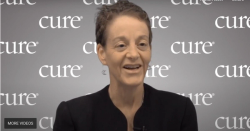- About Us
- Advertise / Support
- Editorial Board
- Contact Us
- CancerNetwork.com
- TargetedOnc.com
- OncLive.com
- OncNursingNews.com
- Terms & Conditions
- Privacy
- Do Not Sell My Information
- Washington My Health My Data
© 2025 MJH Life Sciences™ and CURE - Oncology & Cancer News for Patients & Caregivers. All rights reserved.
Retevmo Is ‘Very Exciting’ for Some with Advanced Thyroid Cancer
Ashley Chan, assistant editor for CURE®, has been with MJH Life Sciences since June 2023. She graduated with a B.A. in Communication Studies from Rowan University. Outside of work, Ashley enjoys spending time with family and friends, reading new novels by Asian American authors, and working on the manuscript of her New Adult novel.
Retevmo as a treatment for patients with advanced RET-mutant medullary thyroid cancer “is very exciting,” as treatment options were previously limited, an expert told CURE®.
Treatment with Retevmo (selpercatinib) demonstrated better outcomes in patients with advanced RET-mutant medullary thyroid cancer, compared with treatment with Cabometyx (cabozantinib) or Caprelsa (vandetanib), two other types of tyrosine kinase inhibitors (TKIs), according to a recent study.
Retevmo is a type of TKI that blocks certain proteins, including the proteins produced by the RET-fusion gene or the RET-mutant gene. When the drug blocks the proteins, it helps prevent cancer cells from growing, the National Cancer Institute defines.
The Food and Drug Administration approved Retevmo for three cancer types with RET alterations, including advanced RET-mutant medullary thyroid cancer, in 2020.
Advanced RET-mutant medullary thyroid cancer is “one of the most rare types of thyroid cancer,” according to Dr. Kaitlyn Frazier, an otolaryngology-head and neck surgery resident at John Hopkins Hospital. However, she noted that it can be difficult to control the source of the tumor once the cancer spreads.
“Once (the tumor has) metastasized, and gone in the bloodstream, it's very hard. You’re kind of just treating these things as they arise kind of like Whac-A-Mole,” Frazier explained. “You can't systematically take (tumors) all out with surgery, and some of these places that they can go to, it's not possible to do surgery, or it will be extremely debilitating and leave patients with a very poor quality of life, depending on where the metastases are.”
A study from The New England Journal of Medicine reported on findings from the phase 3 LIBRETTO-531 randomized trial, which included 291 patients. Two groups were evaluated: 193 patients in the Retevmo group and the control group of Cabometyx (73 patients) or Caprelsa group (25 patients).
According to the study authors, the trial’s primary endpoint (the main result measured at the end of a study to see if treatment worked) was progression-free survival (PFS; the length of time during and after treatment when a patient lives with cancer but does not worsen).
The study authors determined that the 12-month PFS was 86.8% in the Retevmo group and 65.7% in the control group. The 24-month PFS was 76.4% and 37.2%, respectively.
“That's astronomically different, that is twice as many patients,” Frazier said, regarding the trial’s PFS rates, in an interview with CURE®. “And I want to put all that in context: without treatment, these patients with stage 4 medullary, thyroid cancer probably have a 21% 10-year overall survival.”
The most common side effects in the control group, the study authors reported, included diarrhea in 60.8% of patients, hand-foot syndrome in 42.3% and high blood pressure in 41.2%. In the Retevmo group, the most common side effects were high blood pressure in 42.5% of patients, dry mouth in 31.6% of patients, diarrhea in 26.4% and increased levels of alanine aminotransferase enzymes in the liver in 26.4%.
There were higher levels of side effects of any severity in the control group compared with the Retevmo group, according to the study authors. These side effects included — but were not limited to — diarrhea, increased levels of alanine aminotransferase enzymes in the liver, nausea, decreased appetite, hand-foot syndrome, physical weakness, low calcium levels in the blood, vomiting and weight decrease.
As researchers continue to establish more beneficial outcomes for patients regarding Retevmo, Frazier recognized the unmet needs that have been addressed with the drug.
“Ideally, we would be finding this disease earlier and not have to have advanced cases, but it's good to have options across the board,” Frazier noted. “And this is very exciting for those patients where we previously didn't have very much to offer.”
While Retevmo demonstrated significant benefits in terms of PFS versus the control, there are still unmet needs that persist.
“It's valuable to notice that this drug can effectively get (patients) two more years and have good odds of that with (their families). But I think we should dream bigger: we want five years, we want 10 years, we want to be cured. I think that data is still too early to see. It just takes time,” said Frazier.
“(An) exciting thing is, even if the drug can't shrink all these distant metastases, there are options where it can then make something resectable (removable) by surgery that wasn't (possible) before,” Frazier added. “So, it can shrink it to a point where we can take it out without causing some of the harm.”
For more news on cancer updates, research and education, don’t forget to subscribe to CURE®’s newsletters here.
Related Content:



